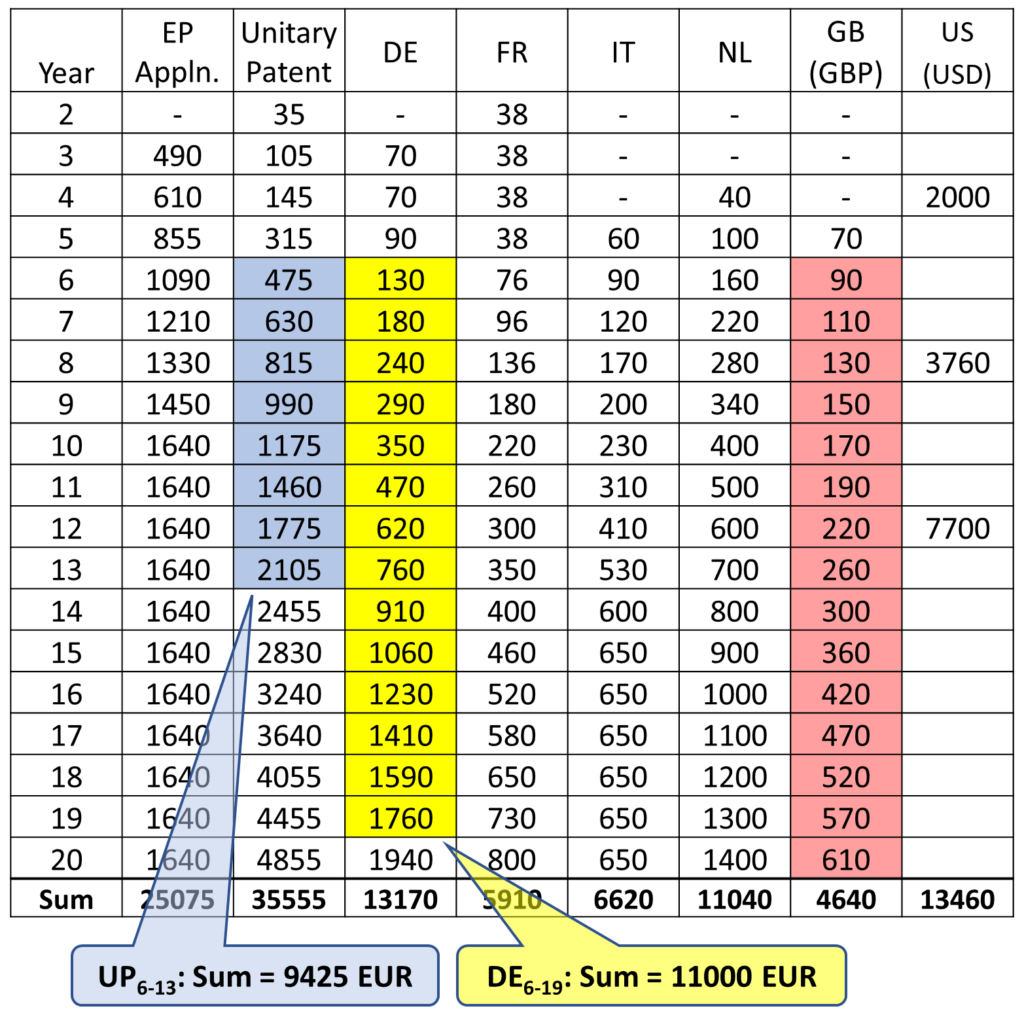This is the second round of my UPC quick tip series, again trying to sort out overly optimistic praises as well as undue critics.
A Unitary patent (UP) will cover one combined territory of currently 17 UPC-participating states (see previous post) with a single patent under exclusive jurisdiction of the UPC, which will hear infringement and revocation proceedings with unitary effect in all said states. Validating an EP patent as bundle of national patents according to different national requirements (including translations, local agents, and annuities) and using national patent jurisdictions remains available for all EPC contracting states as before: for UPC-participating states as alternative to a UP and for non-participating states as only available option.
A decisive factor when choosing between national bundle patents and Unitary patents are the maintenance costs. According to the current schedule, renewal fees of UPs basically correspond to the sum of the four most often validated UPC member states DE+FR+IT+NL (see table below for fees valid March 2022, which may still be changed before entry into force). An additional full text translation is required during a transitional period of at least 6 years – for an EN specification into any other official language of the EU.
Attempts of promotors to declare the UP as inexpensive by comparison with the costs of renewal fees accumulated over all 17 participating states (or even including not yet participating states such as the 25 here) appear rather misleading since almost nobody would ever consider such selection. I think it is well understandable that the planned renewal fees of the UP are often criticized as excessive, in particular when comparing them to the US. The full-text translation is a further nuisance for applicants, costs for validation of non-UPC states (e.g. GB or CH) may come in addition, and there is no possibility of a partial lapse of a UP, i.e. proprietors cannot later switch to only a subset of states at lower costs. In view thereof, many applicants might (at least at the beginning) stick to strategies of validating only few designations without translation requirement (e.g. DE+GB) instead of a UP. This remains the less expensive option to cover the European market in exemplary manner.
On the other hand, such existing few-state validation strategies are typically a hardship solution. Their common usage follows from budget limitations and does not demonstrate that applicants would not be interested in more, as sometimes declared by opponents of the new system. A Unitary patent could strongly simplify strategic choices after grant of an EP patent for many applicants and the promoters are right that further administrative costs are mostly avoided. There are no other translation requirements of individual states or local agents required and payments can be directly effected at the EPO. This clearly brings the EP patent system after grant much closer to how Europe should be. Compared to validations of several states, a UP has advantages in terms of costs (below DE+FR+IT+NL1) and/or territorial scope (DE+FR+IT+NL+13 more), and provides extra effects such as protection from infringements realized in the combined territory but not in individual states. However, simply replacing current selections of multi-state validations by unitary patents would not make full use of its potential. The UP rather calls for adapted validation strategies, and one practical sample will be sketched below.

When taking into account the strong increase of renewal fees in later patent years for the UP as well as the most often selected validation DE, maintaining UPs for fewer years could replace long-term patents in DE at similar costs. For example, for an EP patent granted in year 5, DE annuities cumulated from years 6 to 192 amount to EUR 11000, whereas UP annuities from years 6 to 13 sum up to EUR 9425, the latter leaving some room in the budget for the UP full-text translation.
Such replacement would provide much larger coverage (16 states in addition to DE) until commercial value of the patent is clearer, combined with the remaining discretion to keep the UP longer than originally intended if it turns out to be worth. The often-raised concern that GB does not participate in the UPC may then partly be reverted into an advantage by combining a UP with a national GB validation possibly held until year 20. Renewal fees in GB remain relatively low also in later years and there is no additional translation requirement. Such approach allows to retain a blocking effect in a relevant EP market when the UP is abandoned earlier for cost control or getting revoked. In sum, such “UP6-13+ GB6-20“ patent may be considered as replacement for some of the currently used validations “DE6-19+ GB6-20“. Upon taking the UP as a different product with large coverage but short period in which the value for money is fair, it could be an interesting tool even at the currently planned renewal fees.
The next post will be about risks of the UPC jurisdiction and opt-out decisions.
(previous post of the series)
1 The UP requires only one full-text translation instead of such translation into IT plus a claim translation into NL for the individual validations DE+FR+IT+NL, and there is no longer a need for local agents / addresses for service / payment providers.
2 For DE patents, the 20th year is often not paid because it is expensive and a blocking effect remains for the first half of the 20th year since payment could still be effected within the 6-month surcharge period so that competitors may plan with the lapse only after that.
Comments
1 reply on “UPC quick tip 2 – Costs of Unitary patents”
Thank you for that very nice presentation!